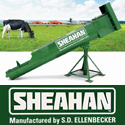 |
 |

|
|
|
Kansas Ag News Headlines |
 |
New Winter Wheat Varieties Available for Fall Planting
Kansas Ag Connection - 08/15/2017
In geographical terms, Kansas is a large, diverse state with significantly less annual average rainfall to the west than in the east, so a one-size-fits-all approach doesn't work for crops grown in the state. To that end, Kansas State University researchers have
developed three new wheat varieties best suited for different growing conditions and available for the first time this year.
Certified seed is available for Larry, Zenda and Tatanka, new hard red winter wheats, each sporting different traits including resistance to certain diseases and pests and in the case of two of them, drought tolerance.
Larry, one of the new varieties, has good resistance to stripe and stem rust and soil-borne mosaic virus -- problems that can plague wheat in Kansas and other states. It has shown good tolerance to acidic soil, but is moderately susceptible to leaf rust. Larry is a
medium maturity that has exhibited good drought resistance and yield potential across south-central and southwest Kansas and into north-central Oklahoma. This wheat was named in honor of Larry Patton, a long-time technician in the K-State wheat breeding
program in Manhattan.
"Larry is a high-performance variety for farmers that are willing to intensively manage their wheat," said Daryl Strouts, president of the Kansas Wheat Alliance, who added that it is important for growers to use a fungicide with this variety.
The Kansas Wheat Alliance is a not-for-profit organization composed of wheat producers, researchers and seed marketers. It manages the release of K-State wheat varieties to deliver crop traits that farmers are seeking for their particular area.
Zenda, another new variety, was named for a community in Kingman County in south central Kansas where it is well adapted. It is "an excellent choice for wheat acres after corn in central and eastern Kansas" and performed well in the 2016 K-State trials in
that area, according to the KWA. It is resistant to soil-borne mosaic and moderately resistant to leaf rust, stem rust and stripe rust. It has intermediate resistance to barley yellow dwarf, powdery mildew, scab and septoria leaf blotch, but is moderately
susceptible to wheat streak mosaic.
"Zenda is the replacement for Everest, the most widely-planted variety in Kansas for the last five years," Strouts said. "It has all the things that make Everest a top variety plus better stripe rust resistance and baking quality."
Tatanka is a new wheat developed particularly for dryland fields in western Kansas. Through years of testing, it has shown high yields, good drought tolerance, winter-hardiness and has good resistance to stripe rust and soil-borne mosaic. It has above-average
test weight and good milling and baking quality. Tatanka was named to honor the American bison or buffalo, another species that at one time thrived on the High Plains. Tatanka comes from the Lakota Indian word for buffalo.
Seed availability should be good for all three varieties, Strouts said, but farmers should be reminded to get their orders in soon as popular varieties like these sell out early.
|
 |


|
 |
|
Copyright © 2024 - Farms.com. All Rights Reserved. |
 |
|